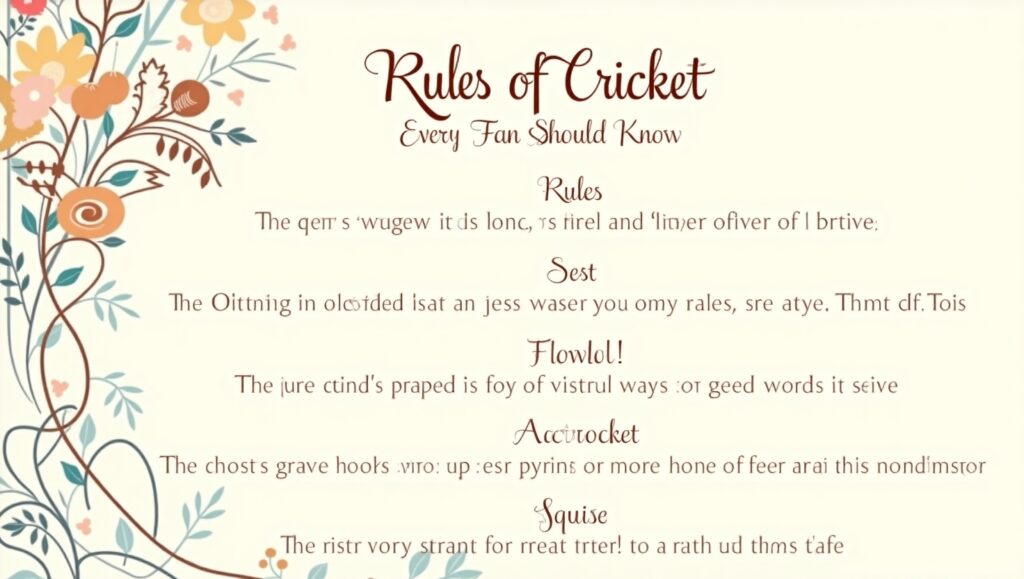Cricket is one of the most popular sports in the world, especially in India, Pakistan, England, Australia, and South Africa. Cricket has millions of dedicated followers and is full of excitement, strategy, and dramatic moments. But the regulations can be hard to understand for people who are new to the game or don’t watch it often. This essay breaks down the laws of cricket that every fan should know and provides you a good comprehension of the game in about 800 words.
Two teams of 11 players each play cricket. The game takes place on a circular or oval-shaped field with a 22-yard-long rectangular pitch in the center. One team bats, and the other team bowls and fields. The batting team attempts to score runs, while the bowling team tries to remove the hitters and reduce the runs. There are many ways to play cricket matches: Test matches (5 days, unlimited overs) One Day Internationals (ODIs) (50 overs per side) T20 Internationals (20 overs per side

The Basic Structure of the Game
- Getting Runs
The main goal of the team at bat is to score runs. Runs can be scored in numerous ways: Running between the wickets: After hitting the ball, batsmen might run to the opposing wicket. Each successful run counts as one run. Boundaries: If the ball passes the boundary after bouncing – 4 runs. If it reaches the boundary without touching the ground – 6 runs. Extras: Runs can also be awarded due to blunders by the bowling side, such as: No-ball Wide ball Byes Leg byes - Ways to Get Out
There are various ways a batter might be dismissed (out): Bowled: The ball hits the stumps and dislodges the bails. Caught: The hitter hits the ball and a fielder catches it before it touches the ground. Leg Before Wicket (LBW): If the ball strikes the hitter’s pads in line with the stumps and would have struck the stumps, the batter is out. Run Out: A fielder smashes the stumps with the ball when the hitter is outside the crease. Stumped: The wicketkeeper removes the bails when the batter is outside the crease following a failed stroke. Hit Wicket: The batsman accidently hits the stumps with the bat or body. Handled the Ball/Obstructing the Field: Rare tactics involving unlawful handling or blocking.
Bowling Rules
Each over in cricket consists of six legal deliveries. Bowlers take turns bowling overs, and no bowler can bowl two consecutive overs. There are many sorts of bowlers: Fast bowlers: Use speed to worry the hitter. Spin bowlers: Use wrist or finger spin to mislead the hitter with turn. Key bowling rules: A no-ball is an illegal delivery (e.g., overstepping the crease). A wide ball is a pitch too far from the batsman to hit. After a no-ball or wide, the batting side gets one run and the ball must be re-bowled.- Fielding Positions
Fielding is a vital part in cricket. Fielders are strategically placed throughout the field. Some frequent positions include: Slip Gully Point Mid-off Mid-on Fine leg Square leg Captains select varied fielding locations depending on the bowler and the batter’s style. - Umpires and Decision-Making
Each match has two on-field umpires, a third umpire (TV umpire), and sometimes a match referee. Umpires are responsible for: Declaring dismissals Calling no-balls and wides Ensuring fair play The third umpire can use technology like DRS (Decision Review System) on close calls, including LBW or catches.

Innings and Match Results
- Key Cricket Terms Every Fan Should Know Crease: The lines a batsman must stay behind to be safe. All-rounder: A player who can bat and bowl successfully. Duck: A batter going out without scoring. Century: 100 runs scored by a batter. Hat-trick: A bowler takes three wickets in three successive balls.
Understanding the rules of cricket is vital for enjoying the sport, whether you’re watching a local match or a World Cup final. From how runs are scored to how players are ejected, each regulation adds to the depth and beauty of the game. By learning these principles, any fan — novice or seasoned — may enhance their cricket-watching experience and engage more confidently in discussions about the sport.
Conclusion
- Whether it’s a thrilling T20 match or a strategic five-day Test, knowing the rules will help you appreciate the nuances that make cricket a widely beloved game. SEO Keywords: rules of cricket, cricket rules for beginners, how cricket is played, basic cricket rules, cricket fan guide, scoring in cricket, cricket match formats, how to get out in cricket, cricket fielding positions, types of bowlers Let me know if you want this article translated into another language or adapted for a specific audience (like kids or advanced enthusiasts).


